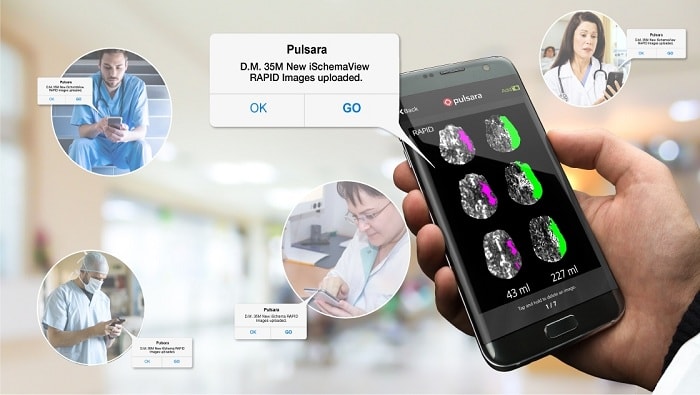Pulsara has expanded its integration strategy by partnering with iSchemaView, the worldwide leader in advanced imaging for stroke.
By leveraging Pulsara’s open API infrastructure, iSchemaView now streamlines the sharing of its RAPID imaging platform for stroke care collaboration globally. Pulsara’s seamless integration with iSchemaView is a natural fit with Pulsara’s stroke module.
“Integration is key. From the outset, we built our platform on an open API infrastructure,” said James Woodson, Pulsara founder and CEO. “By working with iSchemaView, we’re coordinating with a premier partner who is aligned with similar vision and goals — to streamline care collaboration and better patient outcomes.”
Pulsara is a novel mobile platform, developed by physicians, to improve the coordination and communication tasks essential to rapid assessment and care of patients suffering any time-sensitive condition. Its specially-designed stroke workflow within the platform enables clinicians to share images, stroke scores, tPA contraindications and other specialized care information to enable stroke teams to communicate in the most efficient and timely manner. The integration between Pulsara and iSchemaView enables coordinated real-time sharing of iSchemaView’s RAPID images including CTP, MRI and CTA, with the entire stroke team.
Clinicians and patients alike benefit greatly from strategic integrations like this. Improved workflows that allow for coordinated sharing of critical information further advance the vision of automated healthcare communications for entire regions.
“Developed by leading stroke experts, RAPID combines unmatched expert features, proprietary algorithms and machine learning to deliver the best-in-class platform. By integrating with Pulsara, we are able to provide timely diagnosis information within a complete workflow package,” said Don Listwin, CEO of iSchemaView. “With the power of the Pulsara platform, we can share real-time images with the right people at the right time to optimize patient outcomes.”
As stroke is a time-sensitive emergency, state-of-the-art tools that deliver immediate results provide the best chance of treatment success. The RAPID platform automatically provides clear, easy-to-interpret CT and MRI brain images indicating perfusion and angiographic blood flow abnormalities that identify severely damaged tissue vs tissue at-risk. RAPID is the only neuroimaging platform that is FDA-cleared for selecting stroke patients for endovascular clot removal, also known as thrombectomy.
“The patient journey goes beyond one ambulance, one hospital, one neurologist. It’s about connecting a time-sensitive team of clinicians all centered on the patient,” explained Kris Kaull, flight paramedic and chief marketing officer of Pulsara. “By partnering with iSchemaView, a company that is best in class, we are able to dynamically share critical information to key players with a simple tap.”
ABOUT PULSARA
Pulsara provides a real-time communication network across an entire region. The Pulsara platform, built on the power of mobile technology, unites the right clinicians at the right time for the right patient — providing transparency and streamlined communication. Simply CREATE a dedicated patient channel. BUILD the team. And, COMMUNICATE using audio, video, instant messaging, data, images, and key benchmarks. Studies report an average decreased treatment time of nearly 30% when using Pulsara. Pulsara is the evidence-based standard of care.
ABOUT ISCHEMAVIEW
iSchemaView is the world-wide leader in advanced imaging for stroke. Installed in over 1,000 stroke centers, iSchemaView’s RAPID (automated CTP, MRI, CTA and ASPECTS), with enhanced AI framework, is the most advanced stroke imaging platform. In clinical trials, RAPID has been shown to aid in the selection of patients in early and late-window stroke trials, including SWIFT PRIME, EXTEND IA, DAWN, DEFUSE 3 and EXTEND. In addition to achieving the best clinical outcomes and largest treatment effects ever obtained, these landmark studies led to new American Heart Association and American Stroke Association guidelines and have dramatically altered the management of acute stroke around the world.


















